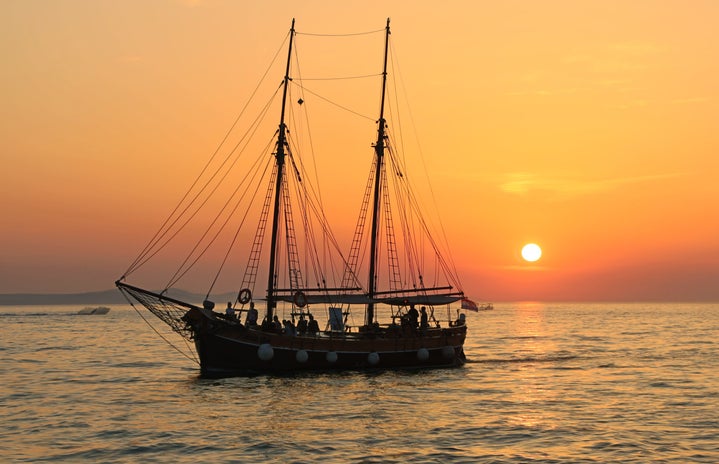This review is spoiler-free.
“One Piece” is currently one of the longest-running and most popular anime, both in Japan and the U.S. The manga it is based off of follows Monkey D. Luffy, one of many pirates who set out to find a coveted mysterious treasure, the One Piece, since 1997. The show itself has been running since 1999 and has been the start of many American anime fans’ love for the craft. And despite having loved anime since fifth grade, I have never seen it.
My main roadblock in exploring the “One Piece” franchise was the sheer time commitment that it takes. The anime alone is 427 hours long and counting. Action-adventure anime also typically does not interest me, but the popularity of the show always had me curious. So, when the biggest “One Piece” fan I know suggested that I watch the recently released live-action adaptation, I considered it. There are eight episodes that are each about an hour long. According to Screen Rant, this covers the story told in about 45 episodes of the anime, obviously with some changes made for time.
American live-action adaptations of anime series get a terrible rap. For instance, the 2017 live-action film adaptation of “Death Note” has a 36% rating on Rotten Tomatoes. It has such a bad reputation that I never even considered watching it, despite being a fan of the source material. Therefore, I was a bit hesitant to dive into the live-action “One Piece.” My friend really wanted me to check it out, and he wasn’t the first person to tell me to do so. Due to their suggestions, and maybe a bit of FOMO, I took the plunge and was pleasantly surprised!
The live-action primarily follows Luffy as he attempts to gather a crew to track down the one piece by attempting to travel to the Grand Line, a dangerous area of the sea. The story begins at a Marines base where Luffy meets Koby first and later Nami, a skilled thief, and Roronoa Zoro, a swordsman carrying three swords. The crew eventually meets Usopp: a compulsive liar and comic relief, and Sanji, a cook.
As someone who has not consumed the source material, the portrayal of these characters was one of the first aspects that drew me in. Iñaki Godoy does an amazing job of capturing Luffy’s innocence and unwavering loyalty to his crew, even in the face of adversity. Luffy is also hilarious and is honestly one of the biggest elements that kept me watching. Mackenyu Arata displays Zoro’s cold sarcasm without making him completely unlikable. Nami has a powerful backstory that is effectively woven into the story, as it is a major plot point as well. The exposition of Zoro’s childhood can feel clunky at times, but is still told well in the form of flashbacks. Even minor characters and villains have compelling backstories. The series did an effective job of providing enough background to explain character motivations and actions without overdoing it.
The cinematography of “One Piece” adds to the fast-paced action. Shots are simultaneously quick and smooth in a satisfying way, especially when characters like Luffy are using their powers. Each new pirate is introduced with the swift motion of a wanted poster followed by them destroying it in a way fit to their characters. It is small details like this which harken back to the source material it draws from. “One Piece” is not ashamed of its roots in manga, instead playing into them. The show also utilizes many well-made visual effects, further immersing the viewer into the universe of the East Blue.
It is difficult to talk about the plot in comparison to the source material when I lack the background knowledge. However, I can say that the story, viewed as standalone, and how each character navigated it, was compelling to me. Without spoilers, it was interesting to see how different classes and groups interacted with the pirates in the story. Often, the crew would try to help a group and would be accepted until Luffy impulsively revealed that they were pirates. He would often then have to clarify that he is “not that kind of pirate.” Characters often had to fight their preconceived notions about what a pirate is and which group in the conflict were really the “bad guys.” This lent itself to social commentary that I truly had not expected going in. I had always thought of the “One Piece” franchise as a whole as a shallow pirate adventure with a ton of filler content, but the live-action pushed me to consider a different perspective entirely. The show has its fair share of raw action and hijinks, but that is not all it is.
Without considering the accuracy of the adaptation, it is clear that the live-action “One Piece” is not simply a cash grab. Everyone involved genuinely seemed to care about making a quality representation of the manga and it shows. The series’ purpose of bringing “One Piece” to a new audience seemed to be effective too, getting 1.31 billion streaming minutes in its first week alone. The series definitely drew me into the world of “One Piece,” and I am anxiously waiting to see what the second season brings. I may even take up the manga, who knows?
The live-action also has the potential to draw new audiences to anime as an entire medium, which is what most adaptations try and fail to do. It proves that making a good adaptation is possible when people care. The success of the series may also pave the way for more care being put into these adaptations. Many people refuse to give anime a chance and are missing out on compelling narratives because of it. If a live-action can open up even one person’s mind to anime, I’m not against it.
All in all, whether you’ve been considering getting into “One Piece” for a while, but it feels too daunting or you’re simply looking for a compelling pirate show, I would recommend the live-action as a great place to start.


